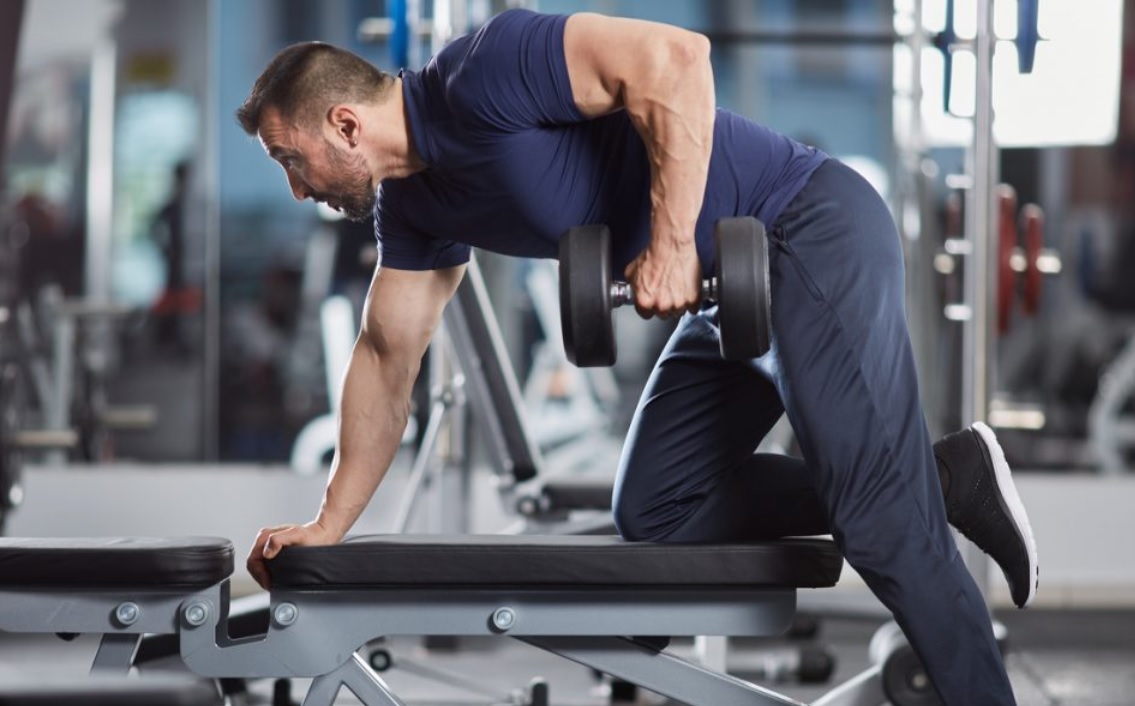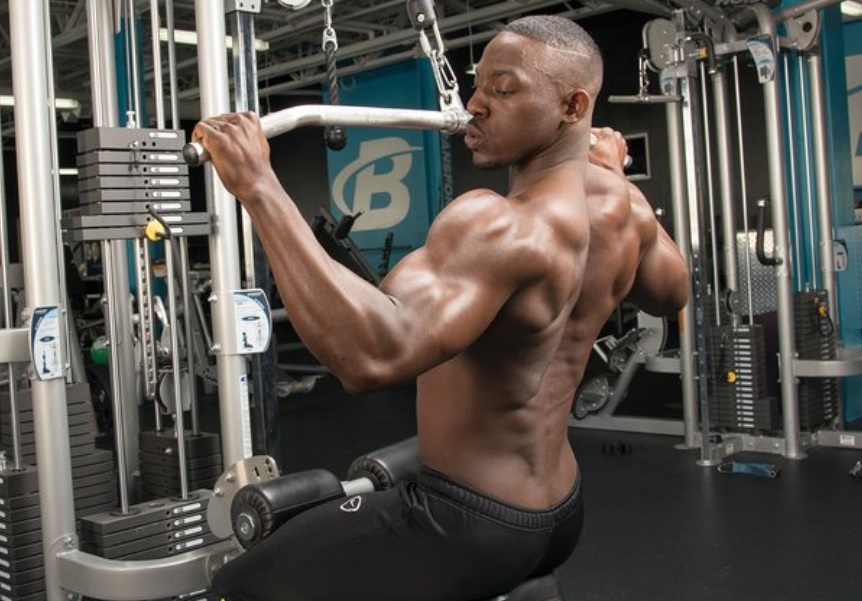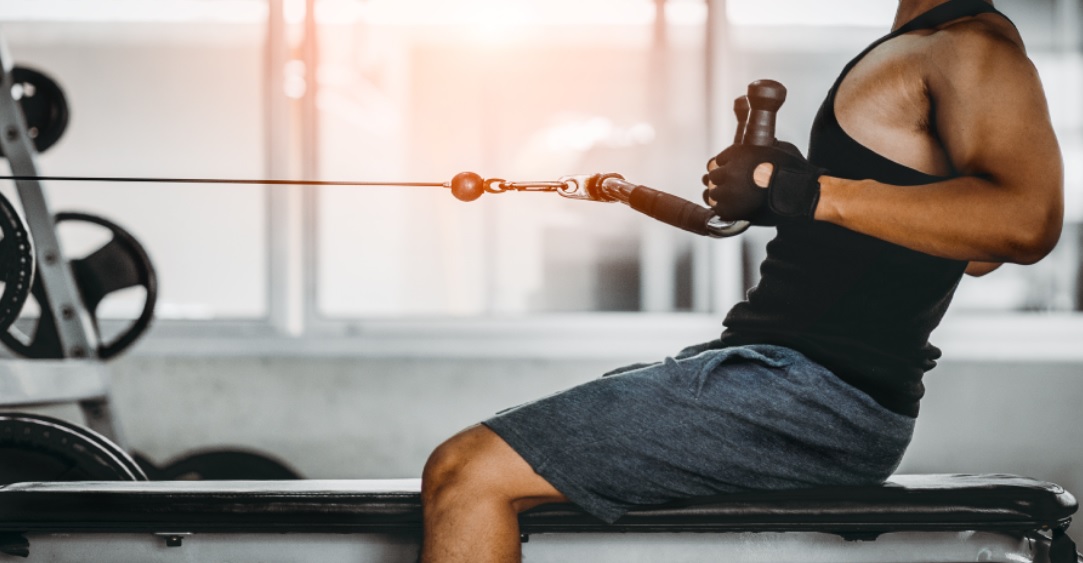Are you weary of feeling like you’re doing your back exercises incorrectly? You’re not alone. A lot of those who are keen on developing the back end up doing the wrong exercises or using the wrong technique. Join us as we go deep into the finest strategies to develop your back muscles.
One Arm Rows – Form Is Everything
One-arm rows are a mainstay of most back workouts, but are you doing them correctly? Traditionally, a heavy weight is grabbed with a neutral hold and pulled straight up. But here’s the catch: by adjusting your form slightly, you may entirely change the workout. You’ll activate your lats more efficiently if you maintain your elbow stationary and row in an arc-like motion.
A pronated grip yielded even better results, with a remarkable 94% lat activation. So, when performing one-arm rows, maintain your form tight and try experimenting with grip modifications for optimum back benefits.
How to Master One-Arm Rows for a Stronger Back
One-arm rows should be a part of your training regimen if you want to have a strong, well-defined back. This traditional exercise works the latissimus dorsi (lats), rhomboids, and middle traps to help you obtain the desirable V-shaped body. To get the most out of one-arm rows, though, you must focus on good form and technique.
For optimum back development, here’s a step-by-step approach to mastering this exercise:
- Proper Setup: Begin by picking a proper dumbbell or kettlebell. The weight should be difficult but achievable, allowing you to complete the exercise correctly. Place the weight on the ground next to a flat bench.
- Assemble: Stand near the bench with your feet shoulder-width apart. Lower your torso till it’s nearly parallel to the ground by bending at the hips and knees. Maintain a straight back, a raised chest, and your free hand on the bench for support.
Use your free hand to lift the dumbbell or kettlebell. Your working arm should be completely extended and hung straight down, with a tiny bend at the elbow.

Carry out the Movement – It’s time to execute the one-arm row with precision:
- On the working side, withdraw your shoulder blade (scapula). As you brace for the pull, imagine pushing your shoulder blades towards your spine.
- Begin the pulling motion by bending your elbow with your scapula engaged. Keep the weight close to your body by pulling it up towards your hip. Lift the weight with your back muscles, particularly your lats.
- Exhale as you lift the weight and keep your core tight throughout the exercise. To lift the weight, avoid utilizing momentum or swinging; this exercise requires controlled, intentional action.
- At the height of the movement, your working arm should be close to your hip and your scapula fully retracted. To feel the contraction, squeeze your back muscles.
- To maximize muscle activation, hold this posture for a brief period.
- Lower the weight slowly, extending your arm fully but keeping tension in your back.
Repetition:
Repeat the appropriate number of times on one side before moving on to the other. Maintaining appropriate form during the set is critical to avoiding injury and properly targeting the relevant muscle groups.
Lat Pull Downs – Choosing the Correct Attachments and Grips
- Lat pull-downs are another important back conditioning exercise. However, the attachment and grip you choose can have a considerable impact on the exercise’s efficacy.
- A wide grip pull-down is a good alternative if you keep your hands wide enough to keep your elbows from breaking the 90-degree angle.
- This focuses your attention on your lats, which results in 63% higher lat activation than bicep activation.
- If you prefer a pullover style, you may improve your lat engagement even further, obtaining a whopping 71% lat activation. To get the most out of this workout, remember to maintain good form.
- Lat pull-downs, when done correctly, target the latissimus dorsi, the major muscles that provide your back breadth and shape.

We will look at how to conduct lat pull-downs correctly to maximise your back’s development and strength.
- Proper Setup:
- Before you begin, make sure the lat pull-down machine is set to your body size.
- Place your feet level on the floor and your knees comfortably under the thigh pads while you sit on the lat pull-down machine.
- Take a broad, overhand hold on the bar, somewhat wider than shoulder-width apart.
- Your palms should be facing away from you.
- Keep appropriate posture:
- Maintaining a strong and stable posture is critical for targeting the correct muscles and preventing injury.
- Maintain a high chest and back shoulders.
- To avoid slouching, keep a tiny arch in your lower back (lumbar curve).
- Stabilise your spine by using your core muscles.
- Maintain a neutral position for your neck by relaxing it.
- Execute the Movement
- Begin by pushing your shoulder blades together. Squeeze them down and back, as if trying to tuck them into your back pockets.
- This scapular retraction is important because it activates the lats, ensuring that they are the major muscles worked during the exercise.
- With your shoulder blades retracted, begin slowly dragging the bar down toward your chest.
- Use your lats to begin and lead the action.
- Exhale as you lower the bar, keeping your abdominal muscles engaged.
- Total Contraction
- Squeeze your lats and hold for a brief minute as the bar reaches your chest to maximize muscle activation.
- Feel your back muscles tense before slowly releasing the bar back to the beginning position.
- Manage the bar release
- As you let go of the bar, let it rise gently, resisting the impulse to snap it back up.
- This eccentric (lengthening) phase is just as critical as the concentric (shortening) phase for muscle growth.
- Repeat and Maintain Proper Form: Perform the specified number of repetitions while maintaining flawless form. It’s critical to pick a weight that lets you move with controlled, purposeful motions during each repetition.
Seated Cable Rows: A Fixed Elbow Is Essential
- Seated cable rows are a great way to work on your back, but your grip and body alignment are important.
- When executing this exercise, keep your elbows in a fixed posture. When this was experimented with three grip modifications, being pronated while maintaining a fixed elbow was the obvious winner.
- It’s critical to engage your lats rather than relying on your biceps.
- Maintaining a constant elbow posture is an important strategy for improving your sitting cable row game.

A fixed elbow in seated cable rows forces your back muscles to do the lion’s share of the work. Here’s how it works:
- By fixing your elbows in place, you eliminate the possibility of using your biceps to help with the pulling motion.
- Your lats, rhomboids, and middle traps are primarily responsible for the rowing movement when your elbows are stationary.
- This isolation of the back muscles ensures that they are the primary beneficiaries of the exercise, leading to more significant muscle engagement and growth.
- Allowing unrestricted elbow movement during rowing exercises can facilitate cheating.
- Individuals often resort to utilizing momentum and engaging additional muscle groups, like the biceps, to lift the weight.
- This form of cheating can compromise the exercise’s effectiveness and impede the progress of your back muscles.
- By maintaining a fixed elbow position, the possibility of employing momentum or other muscle groups is eliminated, compelling you to concentrate exclusively on engaging your back muscles.
- This ensures that each repetition effectively targets the intended muscle group, leading to superior results.
Compound Movements
Compound movements, which engage multiple muscle groups and joints simultaneously, are fundamental to effective back training. Here’s a step-by-step guide on utilizing compound movements to build a stronger back:
Before commencing your workout, it’s essential to choose the most effective compound movements for back development. Some of the most valuable options include:
- Deadlifts: These are pivotal for back training, engaging the entire back, with emphasis on the lower back, lats, traps, and erector spinae.
- Bent-Over Rows: This exercise targets the lats, traps, and rhomboids while also involving the lower back and core. You can perform it with a barbell or dumbbell.
- Pull-Ups and Chin-Ups: These bodyweight exercises primarily target the lats while engaging other upper body muscles, making them ideal for building back strength.
- T-Bar Rows: T-bar rows contribute to overall back development by working the lats, traps, and rhomboids.
- Barbell Shrugs: Although not a traditional compound movement, barbell shrugs focus on the upper traps, aiding in upper back sculpting.

Maintaining correct form is pivotal during compound movements to prevent injury and optimize muscle engagement.
Consider these general form tips for compound exercises:
- Maintain a straight and neutral spine to safeguard your back.
- Engage your core to provide stability and spinal support.
- Employ a full range of motion to maximize muscle activation.
- Prioritize controlled movements, avoiding abrupt or rapid motions.
- Implement proper breathing techniques, exhaling during the effort (lifting phase) and inhaling during the release (lowering phase).
- To promote muscle growth effectively, practice progressive overload by consistently increasing the resistance or weight used in compound movements. Begin with a weight that challenges you while allowing for proper form. As you become more adept, incrementally add more weight over time to continue stimulating muscle growth.
- Prioritize Compound Movements in Your Routine: To build a stronger back, prioritize compound movements in your workout regimen. Consider dedicating a specific day to back training or incorporating compound back exercises into your overall strength training program.
Plan Your Workouts
Organize your back workouts to encompass a mix of compound movements. Here’s an example of a back workout plan:
- Deadlifts: 3-4 sets of 5-8 reps
- Bent-Over Rows: 3-4 sets of 8-10 reps
- Pull-Ups or Chin-Ups: 3-4 sets of as many reps as possible
- T-Bar Rows: 3-4 sets of 8-10 reps
- Barbell Shrugs: 2-3 sets of 10-12 reps
Rest and Recovery
Allocate adequate time for rest and recovery between your back workouts. Building a stronger back involves muscle repair and growth, which primarily occur during rest periods. Aim for at least 48 hours of recovery between intense back workouts.
Nutrition and Hydration
Proper nutrition and hydration play integral roles in muscle growth and recovery. Ensure you consume sufficient amounts of protein, carbohydrates, and healthy fats. Maintaining proper hydration is also essential for optimal performance and recovery.
Monitor Your Progress: Keep track of your progress by documenting your workouts, noting weights lifted, repetitions performed, and any changes in strength and muscle development. This will assist you in adjusting your training plan and sustaining progress.
Bent-over rows and deadlifts are fundamental exercises for targeting the entire back. It’s worth noting that the choice of weight is significant – lighter weights primarily activate the mid-traps, while heavier weights engage the upper traps and lats. Embrace heavier weights to achieve a well-rounded exercise, as they compel your upper traps to stabilize the load. Don’t shy away from heavy weights; they are advantageous for your back.
Mastering your back training involves selecting the right exercises and refining your form. Whether you’re fine-tuning your one-arm rows, choosing the appropriate attachments for lap pull-downs, maintaining a fixed elbow position in seated cable rows, incorporating heavy weights in compound movements, or understanding pull-up variations, there’s always room for improvement in your back workout. Keep in mind that making subtle adjustments can unlock your back muscles’ true potential. So, the next time you hit the gym for a back workout, keep these insights in mind and witness your gains reaching new heights.
Frequently Asked Questions (FAQs):
Can one-arm workouts be utilized to increase muscle and tone the back?
Yes, one-arm workouts can be excellent for both muscle strengthening and back muscle conditioning. The weight and amount of repetitions used will define if the training goal is muscular development or muscle toning.
How is mind-muscle connection important for training?
The mind-muscle connection is pivotal for effective training. It involves consciously engaging and focusing on the specific muscle groups you intend to work on during exercises. This connection is crucial because it enhances muscle activation and engagement, ensuring that you’re targeting the intended muscles with precision. When you mentally concentrate on the muscle being trained, you can recruit more muscle fibers and achieve better contractions, leading to enhanced muscle growth and strength gains.
How important is the latissmus dorsi in strengthening the back and its function?
The latissimus dorsi muscle group is essential for back strength and function. Strengthening the lats not only improves the aesthetics of the back, but also helps with shoulder stability, posture support, core engagement, and a variety of functional activities. Whether your aim is aesthetics, athletic performance, or overall well-being, prioritizing latissimus dorsi development is critical in any thorough back training program.
How often should lats be worked out?
According to research, completing 10 sets per muscle group per week is optimum for hypertrophy, and you may simply divide your lats training across two days using a variety of exercises. Splitting your lat exercises allows the muscles to rest and heal in between sessions.
How many exercises are required for a back workout?
Generally, 2 to 3 back exercises each session are a reasonable amount of exercises to use. In any given session, you can do two back exercises: one vertical pull and one horizontal pull. During a training week, you can do 3-4 different back workouts.









